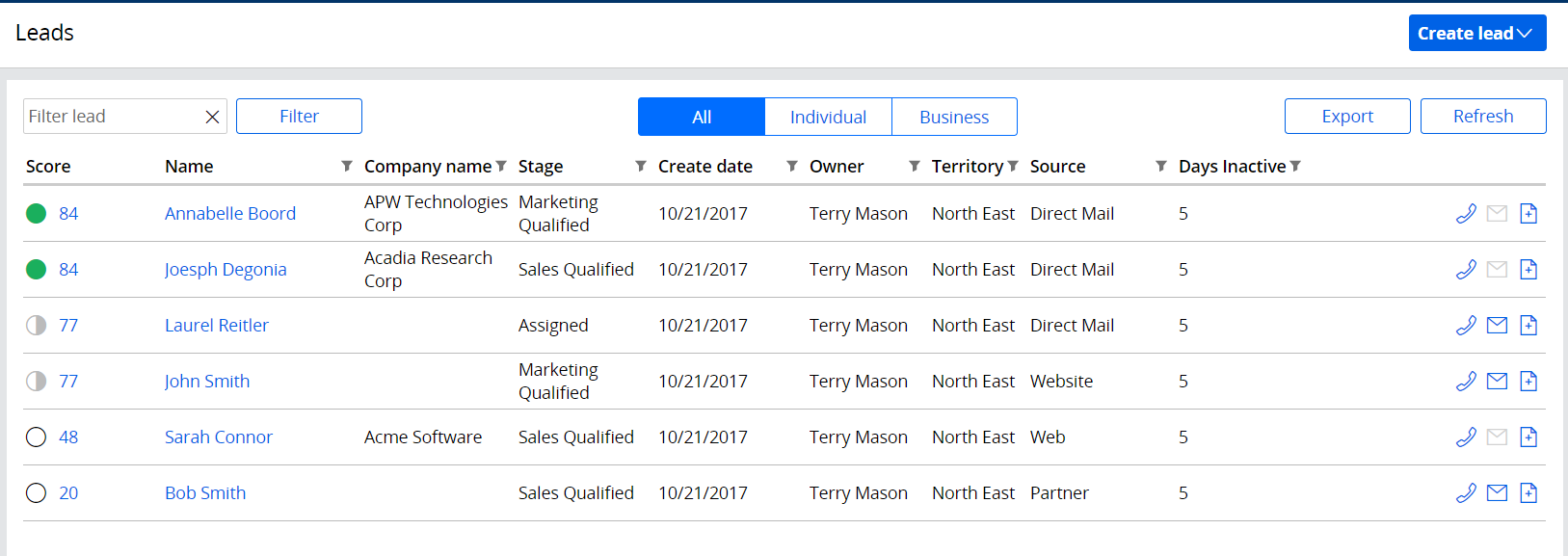Pega Sales Automation 8.2 artificial intelligence-based lead ranking
The Pega Sales Automation™ application uses decisioning capabilities to provide predictive lead scores for lead ranking. The lead score predicts how likely it is that a lead will turn into an opportunity. This helps to focus on the most promising leads to maximize sales.
For information about this process, review the following sections:
Lead score overview
The lead score is displayed on the Leads list page. The lead score is dynamic and responds to changes in the lead properties. For example, the lead score changes when you change the number of activities that are associated with the lead. The lead score can also differ when you change the lead source.
Leads ranking overview
Historical data and adaptive learning
The Pega Sales Automation application uses self-learning, adaptive models to generate the lead score. This approach is based on core decision management capabilities. If needed, add or remove predictors. For more information, see Pega Sales Automation artificial intelligence-based opportunity insights.
Historical data
The adaptive model provides a set of key predictors that are based on the analysis of data from real production environments. For example, the system uses:
- Production data to create weekly snapshots for each closed lead over one-year period
- Records to define core predictors
- Records to train the adaptive models
The following predictors are provided in the Pega Sales Automation adaptive model:
- AvgTimeToConvertLeads
- ContactAge
- DownloadCount
- ExistingCustomer
- Industry
- LeadAge
- LeadCompany
- LeadsContactActivities
- LeadsContactInEmailCount
- LeadsContactOutEmailCount
- LeadRating
- LeadSource
- NoOfActivitiesByMeeting
- NumberOfActivities
- NumberOfActivitiesByEmail
- NumberOfActivitiesByPhone
- NumberOfWonOpportunities
- OrgSubscribeCount
- WebsiteVisitCount
- ValidEmail
- ValidWorkPhone
Adaptive learning
An agent runs daily and executes a data flow that calls a decision strategy. A decision strategy contains the Lead Ranking adaptive model, which represents properties to capture the data that is required by the models. A decision strategy uses the standard Delayed Learning cache.
When a lead is converted to an opportunity or closed without being converted, the system triggers a response strategy from a data flow to retrieve the data for relevant decisions and train the applicable models.
Lead ranking architecture
Review the following lead ranking architecture sections:
Data pages
D_crmLeadsList
The lead score in the leads list runs in the context of the D_crmLeadsList data page. The D_crmLeadList data page has the crmLeadsList report definition data source, which retrieves all lead information from the database. The system uses the data and the CalculateLeadScore rule in post-load processing.
CalculateLeadScore
CalculateLeadScore is a post-processing activity that combines the data for each lead that is available in the PegaCRM-Work-SFA-Lead lead table with the PegaCRM-Data-SFA-LeadPredictors table. The system runs the RankedLead data flow to predict the propensity for each lead. The calculated propensity represents the likelihood for that particular lead to be converted to an opportunity.
Data flows
StoreLeadSnapshots
The StoreLeadSnapshots data flow uses the lead data from the production environment. The StoreLeadSnapshots data flow converts each record from the PegaCRM-Data-SFA-LeadTrainingPredictors class into lead objects. After that, the system routes converted records to the EvaluateLeadRanking strategy. Use the Make decision and store data for later response capture mode for EvaluateLeadRanking strategy.
CaptureLeadOutcomes
The LeadRankingOutcomes report definition is the input for the CaptureLeadOutcomes data flow. The LeadRankingOutcomes report definition retrieves one record per lead from the historical predictors data table, sorted by the maximum snapshot date. The system then retrieves the outcome for each lead. The CaptureLeadOutcomes data flow calls the LeadRankingCloseProbation data flow.
LeadRankingUpdate
The system invokes the LeadRankingUpdate data flow by using the SA-Artifacts agent. The SA-Artifacts agent stores the daily lead snapshot. The system collects lead static data and predictor data for each lead. The system then routes the data to the EvaluateRanking strategy. Change the mode to Make decision and store data for later response capture.
LeadRankingCloseProbation
The system uses the LeadRankingCloseProbation data flow to set the outcome for a lead when an outcome is triggered, such as when the system converts a lead into an opportunity or when it closes a lead.
RankLead
The RankLead data flow runs on a demand basis. The system invokes the RankLead data flow by using the CalculateLeadScore activity for each lead to calculate the lead score. The RankLead data flow collects predictor properties for each lead and the lead static data. After the system collects lead static and predictor properties data, it routes the data to the EvaluateLeadRanking strategy to calculate the lead score. Use the Make decision mode for the EvaluateLeadRanking strategy.
To view the data flow details, perform the following steps:
- In the explorer panel in Dev Studio, click Records > Data Model > Data Flow.
- Select a data flow to open it and view the data flow record.
Strategies
- EvaluateLeadRanking
- CloseLead
To view the strategy details, perform the following steps:
- In the explorer panel in Dev Studio, click Records > Decision > Strategy.
- Select a strategy to open it and view the strategy record.
Adaptive models
The lead architecture includes the LeadRanking adaptive model that provides predictors based on the historical data. The input predictor range should be as complete as possible before training the adaptive models to predict outcome propensities based on your use cases, configure predictors, context, and outcomes for the adaptive model.
To view the adaptive models details, perform the following steps:
- In the explorer panel in Dev Studio, click Records > Decision > Adaptive Model.
- Select an adaptive model to open it and view the adaptive model record.
- To set lead ranking outcomes, define positive or negative outcome values on the tab.
- View the advanced settings, such as performance monitoring or data analysis binning, open the tab.
Previous topic Pega Sales Automation artificial intelligence-based lead ranking Next topic Activating and training adaptive models for artificial intelligence in Pega Sales Automation

